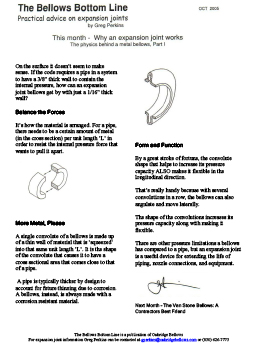Why An Expansion Joint Works – Part I

On the surface it doesn’t seem to make sense. If the code requires a pipe in a system to have a 3/8” thick wall to contain the internal pressure, how can an expansion joint bellows get by with just a 1/16” thick wall?
Balance the Forces
It’s how the material is arranged. For a pipe, there needs to be a certain amount of metal (in the cross section) per unit length ‘L’ in order to resist the internal pressure force that wants to pull it apart.
More Metal, Please
A single convolute of a bellows is made up of a thin wall of material that is ‘squeezed’ into that same unit length ‘L’. It is the shape of the convolute that causes it to have a cross sectional area that comes close to that of a pipe.
A pipe is typically thicker by design to account for future thinning due to corrosion. A bellows, instead, is always made with a corrosion resistant material.
Form and Function
By a great stroke of fortune, the convolute shape that helps to increase its pressure capacity ALSO makes it flexible in the longitudinal direction.That’s really handy because with several convolutions in a row, the bellows can also angulate and move laterally. The shape of the convolutions increases its pressure capacity along with making it flexible. There are other pressure limitations a bellows has compared to a pipe, but an expansion joint is a useful device for extending the life of piping, nozzle connections, and equipment.


